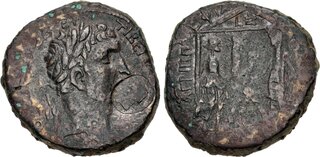Lot description:
JUDAEA, Herodians. Agrippa II, with Claudius. 37-43 CE. Æ (26mm, 16.02 g, 12h). Caesarea Maritima mint. Dated RY 7 of Agrippa I (42/3 CE). Laureate head of Claudius right; c/m: laureate head left within incuse circle / Two figures (Claudius and Agrippa?) standing facing one another, each holding patera, within distyle temple; between, torso of figure holding uncertain object above victimarius kneeling left, restraining offering; L Z (date) in pediment. Burnett, Coinage 10; Meshorer 121; RPC I 4983. For c/m: Howgego 156. Red-brown surfaces, smoothed and tooled, spots of green verdigris. Coin, Good Fine; c/m, Fair. Rare.
Agrippa I had a close relationship with both Gaius (Caligula) and Claudius, in part helping to secure the rule of the latter in the uncertain days following his unexpected rise to the purple by counseling the understandably shaken Claudius and entreating the Senate to support him. Indeed, his relationship with Claudius was sufficiently close that Josephus (Ant. xix. 5.1) records that among the new emperor's first acts was the publication of an edict guaranteeing Agrippa's kingdom (with the title "great king") and granting the territory of Chalcis to Agrippa's elder brother Herod.
Burnett believed the scene on the reverse represented the consecration of this treaty in Rome, a treaty which is specifically mentioned by Josephus (He also made a league with this Agrippa, confirmed by oaths, in the middle of the Forum in the city of Rome. [Jospehus, Ant. xix.5.1]). Although Suetonius (Suetonius, Claud. 25.5) also places the rites of the treaty (or fetial ceremony), which included the sacrifice of a pig, in the Roman Forum, Burnett argued that they instead took place at the Temple of Jupiter Capitolinus. Following Burnett's interesting argument, this rare Judaean bronze not only represents a religious ceremony before the holiest temple of Rome, but accurately depicts a victimarius (sacrificial assistant) about to kill a pig.
Estimate: 200 USD |  |